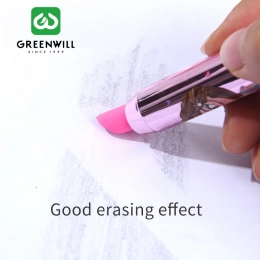Eraser is a common stationery item in our daily life. It is used to erase traces of drawing tools such as pencils and colored pencils. However, the question of whether erasers are toxic has always been a concern. In this article, we'll look at the ingredients of erasers, their safety, and the potential risks that may arise from their use.
First, let's take a look at the main ingredients of an eraser. Generally speaking, the main component of an eraser is rubber. Rubber is an elastic material, usually made of natural or synthetic rubber. Natural rubber is mainly derived from the latex of the rubber tree, while synthetic rubber is prepared through chemical synthesis. In addition to rubber, erasers may also contain auxiliary ingredients such as fillers, plasticizers, and antioxidants, which help improve the performance and service life of the eraser.

However, even though the main component of the eraser is rubber, it does not mean that the eraser is completely harmless. In the production process of erasers, some chemicals may be used, such as benzene, formaldehyde, phthalates, etc. These chemicals may affect human health to a certain extent. For example, benzene is a toxic substance, and long-term exposure may cause dizziness, nausea, vomiting, and other symptoms; formaldehyde is a pungent odor substance, and long-term exposure may cause irritation to the respiratory tract and skin.
In addition, there are also some potential risks during the use of erasers. When we use an eraser to erase pencil marks, the eraser will produce rubber shavings, which may be inhaled into the respiratory tract and cause certain irritation to the respiratory system. In addition, the eraser will also generate static electricity during the erasing process, adsorbing dust and bacteria in the air, which may have a certain impact on human health.
In view of the possible safety hazards of erasers, some countries and regions have regulated the safety standards of erasers. For example, the European Union has restricted the formaldehyde release, benzene content, and other indicators of erasers, requiring erasers to meet corresponding safety standards before they can be put on the market. In addition, some eraser manufacturers have also begun to pay attention to green environmental protection and have launched environmentally friendly erasers that do not contain harmful substances to reduce the impact on human health and the environment.


Greenwill stationery TPR material erasing power is at the leading level in the industry, we can pass the stringent testing requirements of internationally renowned brands such as MAPED, BIC and FABER-CASTELL, and the testing standards of DUKE University Laboratory.
Different from traditional PVC erasers, TPR is environmentally friendly and non-toxic and has no pollution to the environment. It avoids the damage caused by the long-term use of PVC rubber to the global environment and human health.
When using erasers on a daily basis, we can also take some measures to reduce the risks that erasers may bring. First of all, choose erasers of reliable quality and try to avoid buying erasers from unknown sources and substandard quality; secondly, when using erasers, try to maintain a well-ventilated environment to reduce the impact of eraser chips and static electricity on health; finally, after erasing, clean your hands promptly to avoid bringing eraser scraps into the mouth or other parts of the body. In order to avoid accidentally eating erasers, parents and guardians should strengthen supervision of children and place small items such as erasers out of the reach of children to ensure their safety.
Ingesting an eraser is not an uncommon occurrence. Especially among school-age children, it often happens that they mistake erasers for food or toys. When you accidentally eat an eraser, you must first stay calm and don't panic. Next, you can take the following measures:
Give Water: If someone swallows a small eraser, have them drink plenty of water. This can help the eraser pass through their body more easily and reduce irritation in their stomach.
See a Doctor: If the person has discomfort like vomiting, stomach pain, or trouble breathing, they should see a doctor right away. The doctor will assess their situation and suggest the right treatment.
Watch for Symptoms: After swallowing an eraser, keep an eye on any changes in how they feel. If serious symptoms appear, seek medical help promptly.
Don't Make Them Vomit: It's generally not a good idea to make someone vomit if they accidentally eat an eraser. Vomiting can worsen stomach discomfort caused by the eraser.
To sum up, erasers may have some safety hazards to a certain extent, but by choosing products with reliable quality and paying attention to the use environment and personal hygiene, we can effectively reduce the risks that erasers may bring. At the same time, eraser manufacturers should also strengthen the quality control of eraser products, promote the popularization of green and environmentally friendly eraser products in the market, and provide people with safer and healthier stationery.
mia
James@tinlongworld.com


